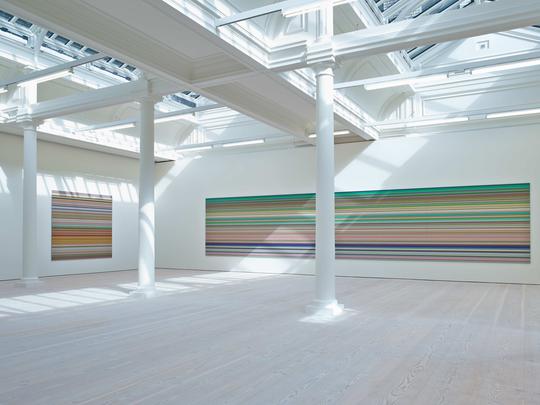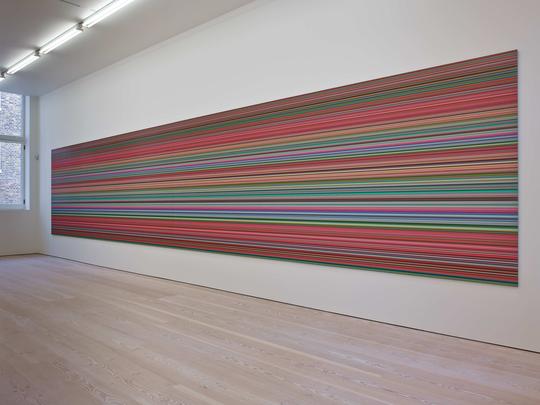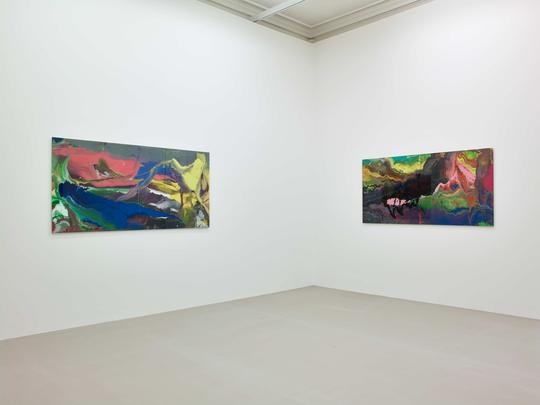 |
| Gerhard Richter, Strip 930-1, 2013 |
Marian Goodman has finally opened an
exhibition space in London. It is stunning. In an old industrial space on
Golden Square in Soho, it’s grand, spacious and on the evening I visited, was filled
with London’s misty late autumn light. Anyone who thinks they have seen enough Gerhard Richter paintings, will still want to visit gallery’s inaugural
exhibition, Gerhard Richter, if for
no other reason than to be inside this inspiring new space. And anyone – like
me – who thinks they have already seen the Richter works needs to see them here on display at Marian Goodman. Because their inhabitation of the superb new
space makes it like seeing them for the first time.
 |
| Gerhard Richter, 7 Panes of Glass (House of Cards), 2013 |
House
of Cards is perhaps Richter’s most baroque, and
simultaneously, futuristic piece of art. It is filled with distortions,
reflections, fragility and a monumentality that dissolves as soon as we are
absorbed into the piece through our reflection on the glass faces. In typical
Richter contradiction, the glass sheets remind us both of Richard Serra’s precariously
placed steel plates and, of Richter’s own accord, the ice flows of Casper David
Friedrich’s The Sea of Ice (1823-24). They are both
fragile and intransigent, continually shifting and incomprehensible. Filled
with the reflection of neon lights, other paintings, and the visitors who try
to make sense of the House of Cards,
the glass sheets are mesmerizing.
 |
| Gerhard Richter, Doppelgrau, 2014 |
A series of four Doppelgrau, 2014 works are Richter’s most recent pieces in the exhibition.
Paint and glass come to belong together to create diptychs. While Richter has
fused paint and glass together for years, Doppelgrau introduce something new to
his oeuvre. They go back to grey, an intensity of and serious focus on grey
that has not been seen since the Eight
Grey were presented at the Deutsche Guggenheim in 2002. And like those works, we question the status of Doppelgrau.
Are they sculpture? Paintings? Architectural? Is it important to distinguish
the two different greys? Or even, what shade of grey is actually used? And what
is the reference to art history? They are diptychs afterall. Unlike painting
as we know it, the Doppelgrau works encourage
us not to look. We are distracted by the reflection of other paintings, and
beyond their existence on the wall of the gallery, there is nothing to look at.
I was left with more questions than answers for Doppelgrau.
 |
| Gerhard Richter, Installation View at Marian Goodman on Golden Square |
Upstairs, under the iron and glass windows
of the old factory ceiling, a series of Strip
paintings from 2012 and 2013 fill the walls. Here, Richter’s painting has become clean,
cold, and finite – but then, of course, as usual, these examples are simultaneously, none
of these. The lines extend forever off the side of the image. I was enthralled
to find – especially with the ten metre long versions – the velocity of the
works. Up close, there is nothing to see, nothing to contemplate, and so, I
walked the length of the painting, to find it had me racing, moving at a high
and intense speed. There was nothing finite or cold about it. I can’t
describe the logic behind the speed of physical movement they encourage, even demand. I just
noticed that they had this effect. And yet, in the middle of the room, away
from their influence, I felt as though I was standing in a cathedral built for
the Strip paintings. Light pours
through the windows, and without me up close, the paintings are left with each
other, creating a perfection that makes them holy. They sit there in this
magnificent space, together in complete silence.
 |
| Gerhard Richter, Strip 930-2, 2013 Installation View |
The Strip
paintings are like landscapes, horizontal, and infused with the familiar
Richter elusiveness. I wonder if they are so different from the fifty years of
paintings that precede them. They may have lost the luscious, tactile oil paint
of the overpainted photographs, but the sensuousness has only been
transformed, it is not erased. It is no longer found on the surface, in the
paint, but it can be found in the unpredictability of the interaction, between
the movement, placement of the viewer and the paintings themselves. As Richter gets older, his work becomes
increasingly conceptual. There is nothing to do but walk along the length of
the Strip paintings, because they are
all but impossible to look at. Their movement, their psychedelic colours hurt
the eye with optical illusions. Here the image has all but disappeared. So we
have reached this place where not only is there nothing to see, but like the
cinema, Richter's image no longer exists an object. Painting has become transparent, translucent
and not even a surface. Or at least, when it is a surface, it is simultaneously
violated as a surface.
 |
| Gerhard Richter, Flow 933-4, 2013 and Flow 933-3, 2013 Installation View |
The paintings I find least appealing are also those that seem to capture all that Richter's work is about: the Flow paintings are about being in process. In these paintings, the unexpected here arises out of and in the
narrative unfolding – Flow captures
that invisible moment that can’t be touched. It is the randomness of the moment
that Richter decides to stop. And this is the moment that he gives to us in a painting, a moment that is always elusive, always in the process of becoming something that we can never touch, and in his most recent works, can no longer see.
No comments:
Post a Comment